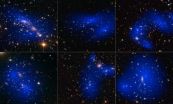New study shows bacteria can use magnetic particles to create a 'natural battery'
2015-03-26
(Press-News.org) New research shows bacteria can use tiny magnetic particles to effectively create a 'natural battery.' According to work published in journal Science on 27 March, the bacteria can load electrons onto and discharge electrons from microscopic particles of magnetite. This discovery holds out the potential of using this mechanism to help clean up environmental pollution, and other bioengineering applications. The European Association of Geochemistry is highlighting this work as especially interesting.
According to study leader Dr James Byrne (Tübingen):
"The geochemistry is interesting in itself, but there are also potentially useful implications which may derive form this work. The flow of electrons is critical to the existence of all life and the fact that magnetite can be considered to be redox active opens up the possibility of bacteria being able to exist or survive in environments where other redox active compounds are in short supply in comparison to magnetite. In our study we only looked at iron metabolizing bacteria, but we speculate that it might be possible for other non-iron metabolizing organisms to use magnetite as a battery as well - or if they can be made to use it, through genetic engineering. But this is something that we do not know yet"
Researchers from the University of Tübingen, the University of Manchester, and Pacific Northwest National Laboratory, USA, incubated the soil and water dwelling purple bacteria Rhodopseudomonas palustris with magnetite and controlled the amount of light the cultures were exposed to. Using magnetic, chemical and mineralogical analytical methods, the team showed that in light conditions which replicated the day-time, phototrophic iron-oxidizing bacteria removed electrons from the magnetite, thereby discharging it. During the night-time conditions, the iron-reducing bacteria took over and were able to dump electrons back onto the magnetite and recharge it for the following cycle.
This oxidation/reduction mechanism was repeated over several cycles, meaning that the battery was used over repeated day-night cycles. Whilst this work has been on iron-metabolizing bacteria, it is thought that in the environment the potential for magnetite to act as a battery could extend to many other types of bacteria which do normally not require iron to grow, e.g. fermenters.
Co-author, Andreas Kappler (Tübingen), who is also secretary of the European Association of Geochemistry, said:
"This may have some interesting geochemical applications. There has been considerable recent work on using magnetite to clean up toxic metals. For example, magnetite can reduce the toxic form of chromium, chromium VI, to the less toxic chromium (III), which can then be incorporated into a magnetite crystal. The fact that this magnetite may then be exposed to these reducing bacteria could potentially enhance its remediation capacity. But we are still at an early stage of understanding the bioengineering implications of this discovery".
INFORMATION:
ELSE PRESS RELEASES FROM THIS DATE:
2015-03-26
A study led by Cathy Spatz Widom, Distinguished Professor of Psychology at John Jay College, found that offspring of parents with histories of child abuse and neglect are themselves at risk for childhood neglect and sexual abuse but not physical abuse. Titled "Intergenerational Transmission of Child Abuse and Neglect: Real or Detection Bias?" the study's findings were reported in the March 27 issue of the journal Science.
As part of a prospective longitudinal study, Widom followed a large group of children with documented cases of childhood abuse and neglect and a demographically ...
2015-03-26
A new study, published today in the journal PloS Neglected Tropical Diseases has given new insights into the spread of rabies in the Middle East, showing that the deadly disease regularly moves between countries in the region.
The international team of researchers including scientists from the University of Surrey and the Animal and Plant Health Agency, have mapped the spread of rabies in the region to help inform control methods.
Previous studies have demonstrated that rabies, a fatal disease transmitted by the bite or scratch from an infected animal, still kills approximately ...
2015-03-26
Dark matter is one of science's great mysteries. It makes up an enormous amount matter in the universe, it is invisible, and it does not correspond to anything in the realm of our experience. Different theories compete for an explanation, but so far none of them has prevailed. In a collaborative study between École Polytechnique Fédérale de Lausanne (EPFL) and the University of Edinburgh, scientists have studied how dark matter behaves when galaxy clusters collide with each other over billions of years. Published in Science, their findings challenge at least ...
2015-03-26
Foraging bats obey their own set of 'traffic rules', chasing, turning and avoiding collisions at high speed, new research from the University of Bristol, UK has found.
Dr Marc Holderied of Bristol's School of Biological Sciences studied pairs of Daubenton's bats (Myotis daubentonii) foraging low over water for stranded insects at a site near the village of Barrow Gurney in Somerset, UK.
He said: "Collective movements of flocking birds or shoaling fish are amongst the most fascinating natural phenomena, and everyone has experienced the challenges of walking through ...
2015-03-26
CHAPEL HILL, NC - A team of researchers has discovered HIV can begin replicating in the brain as early as four months after initial infection. The study followed 72 treatment naïve participants during the first two years of HIV infection. Through analysis of cerebral spinal fluid (CSF) and blood samples, 20 percent of subjects showed replication in the central nervous system (CNS) at four months. Additionally, 30 percent of participants showed evidence of a marked CSF inflammatory response in at least one time point and 16 percent of study volunteers showed a marked ...
2015-03-26
The fact that the neutron is slightly more massive than the proton is the reason why atomic nuclei have exactly those properties that make our world and ultimately our existence possible. Eighty years after the discovery of the neutron, a team of physicists from France, Germany, and Hungary headed by Zoltán Fodor, a researcher from Wuppertal, has finally calculated the tiny neutron-proton mass difference. The findings, which have been published in the current edition of Science, are considered a milestone by many physicists and confirm the theory of the strong interaction. ...
2015-03-26
Astronomers using observations from the NASA/ESA Hubble Space Telescope and NASA's Chandra X-ray Observatory have studied how dark matter in clusters of galaxies behaves when the clusters collide. The results, published in the journal Science on 27 March 2015, show that dark matter interacts with itself even less than previously thought, and narrows down the options for what this mysterious substance might be.
Dark matter is a giant question mark looming over our knowledge of the Universe. There is more dark matter in the Universe than visible matter, but it is extremely ...
2015-03-26
Say you're out shopping for basic household goods -- perhaps orange juice and soup. Or light bulbs. Or diapers for your young child. How do you choose the products you buy? Is it a complicated decision, or a simple one?
It could be complex: Factors like price, quality, and brand loyalty may run through your mind. Indeed, some scholars have developed complicated models of consumer decision-making, in which people accumulate substantial product knowledge, then weigh that knowledge against the opportunity to explore less-known products.
But in a new paper, MIT researchers ...
2015-03-26
(WASHINGTON - March, 26, 2015) - A committee of lymphoma experts today unveiled a strategic roadmap identifying key priority areas in both infrastructure and research that will be critical for advancing treatments for people with lymphoma. The report is meant to inform future research directions as well as funding decisions by strategic partners that could include government agencies and the private sector. The strategic recommendations were developed after a review of the state of the science in lymphoma conducted at a special ASH Meeting on Lymphoma Biology held in August ...
2015-03-26
EAST LANSING, Mich. -- It may sound like the makings of a joke, but answering the question of how chickens crossed the sea may soon provide more than just a punch line.
Michigan State University researcher Eben Gering has collaborated with a team in a study of the mysterious ancestry of the feral chicken population that has overrun the Hawaiian Island of Kauai. Their results, published in the current issue of Molecular Ecology, may aid efforts to curtail the damage of invasive species in the future, and help improve the biosecurity of domestic chicken breeds.
Domesticated ...
LAST 30 PRESS RELEASES:
[Press-News.org] New study shows bacteria can use magnetic particles to create a 'natural battery'


